remove seats Citroen BERLINGO MULTISPACE 2015 2.G User Guide
[x] Cancel search | Manufacturer: CITROEN, Model Year: 2015, Model line: BERLINGO MULTISPACE, Model: Citroen BERLINGO MULTISPACE 2015 2.GPages: 298, PDF Size: 12.69 MB
Page 129 of 298
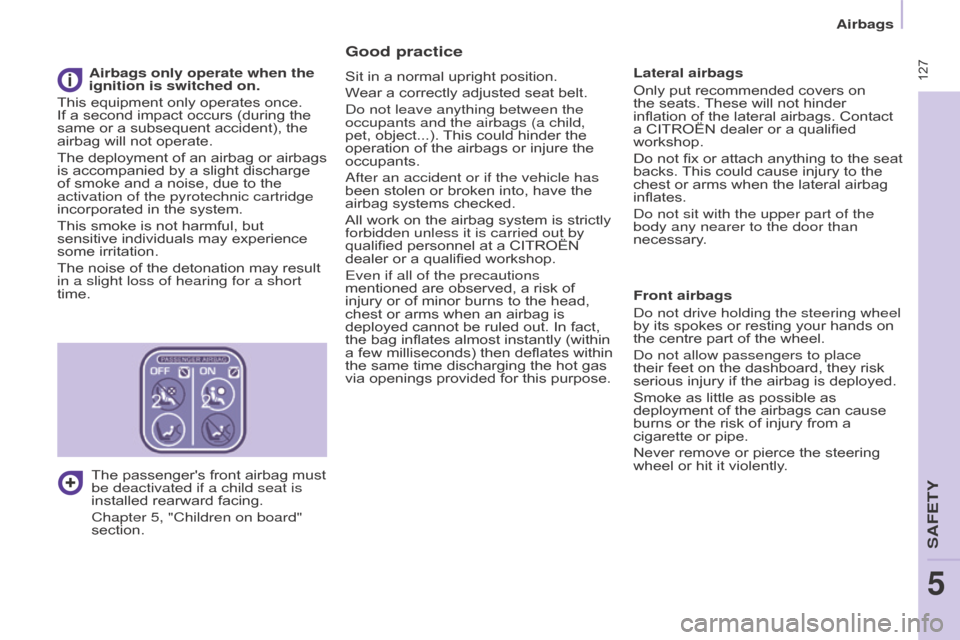
Berlingo-2-VP_en_Chap05_Securite_ed01-2015
127
Good practice
Sit in a normal upright position.
W ear a correctly adjusted seat belt.
d
o not leave anything between the
occupants and the airbags (a child,
pet,
object...).
This
could hinder the
operation
of the airbags or injure the
occupants.
a
fter an accident or if the vehicle has
been
stolen or broken into, have the
airbag
systems checked.
All
work on the airbag system is strictly
forbidden unless it is carried out by
qualified
personnel at a CITROËN
dealer
or a qualified workshop.
Even if all of the precautions
mentioned
are observed, a risk of
injury
or of minor burns to the head,
chest
or arms when an airbag is
deployed
cannot be ruled out. In fact,
the
bag inflates almost instantly (within
a
few milliseconds) then deflates within
the
same time discharging the hot gas
via
openings provided for this purpose.Lateral airbags
Only
put recommended covers on
the
seats.
These
will not hinder
inflation
of the lateral airbags. Contact
a
CITROËN dealer or a qualified
workshop.
Do
not fix or attach anything to the seat
backs.
This
could cause injury to the
chest
or arms when the lateral airbag
inflates.
d
o not sit with the upper part of the
body any nearer to the door than
necessary.
Front airbags
d
o not drive holding the steering wheel
by
its spokes or resting your hands on
the
centre part of the wheel.
d
o not allow passengers to place
their
feet on the dashboard, they risk
serious
injury if the airbag is deployed.
Smoke
as little as possible as
deployment
of the airbags can cause
burns
or the risk of injury from a
cigarette
or pipe.
Never
remove or pierce the steering
wheel
or hit it violently.
Airbags only operate when the
ignition is switched on.
This
equipment
only
operates
once.
If
a
second
impact
occurs
(during
the
same
or
a
subsequent
accident),
the
airbag
will
not
operate.
The
deployment
of
an
airbag
or
airbags
is
accompanied
by
a
slight
discharge
of
smoke
and
a
noise,
due
to
the
activation of the pyrotechnic cartridge
incorporated
in
the
system.
This
smoke
is
not
harmful,
but
sensitive
individuals
may
experience
some
irritation.
The
noise
of
the
detonation
may
result
in a slight loss of hearing for a short
time. The
passenger's
front
airbag
must
be deactivated if a child seat is
installed
rearward
facing.
Chapter 5, "Children on board"
section.
airbags
SaFETY
5
Page 139 of 298
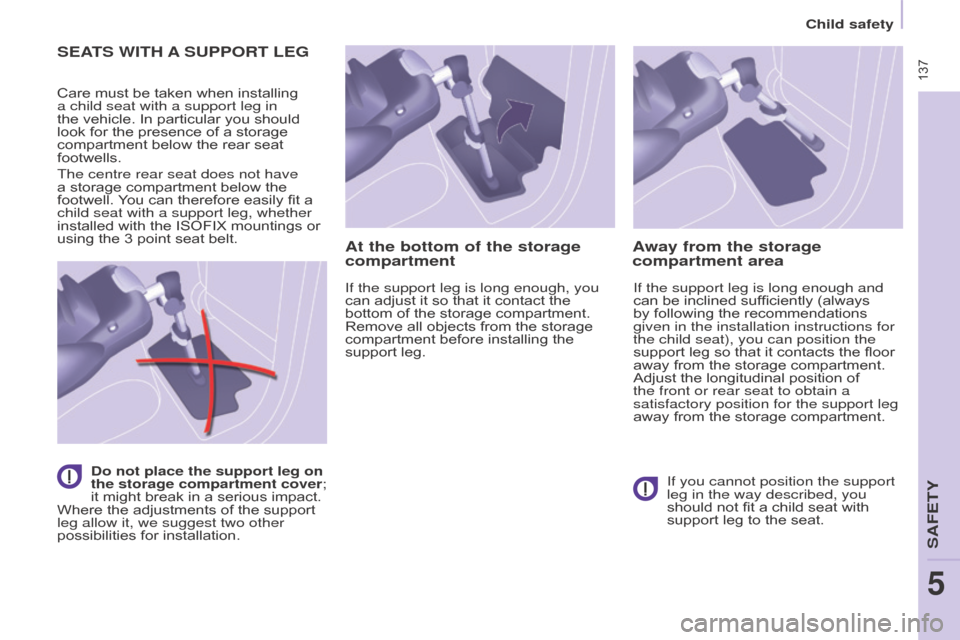
Berlingo-2-VP_en_Chap05_Securite_ed01-2015
137
SEATS WITH A SUPPORT LEG
Care must be taken when installing a child seat with a support leg in
the
vehicle. In particular you should
look
for the presence of a storage
compartment
below the rear seat
footwells.
The centre rear seat does not have
a
storage compartment below the
footwell.
Y
ou can therefore easily fit a
child seat with a support leg, whether
installed
with the ISOFIX mountings or
using
the 3 point seat belt.
Do not place the support leg on
the storage compartment cover;
it
might break in a serious impact.
Where
the adjustments of the support
leg allow it, we suggest two other
possibilities
for installation.
At the bottom of the storage
compartment
If the support leg is long enough, you
can adjust it so that it contact the
bottom
of the storage compartment.
Remove
all objects from the storage
compartment
before installing the
support
leg.
Away from the storage
compartment area
If the support leg is long enough and
can be inclined sufficiently (always
by
following the recommendations
given in the installation instructions for
the child seat), you can position the
support
leg so that it contacts the floor
away
from the storage compartment.
Adjust
the longitudinal position of
the front or rear seat to obtain a
satisfactory position for the support leg
away
from the storage compartment.
If you cannot position the support
leg in the way described, you
should
not fit a child seat with
support
leg to the seat.
Child safety
SaFETY
5
Page 141 of 298
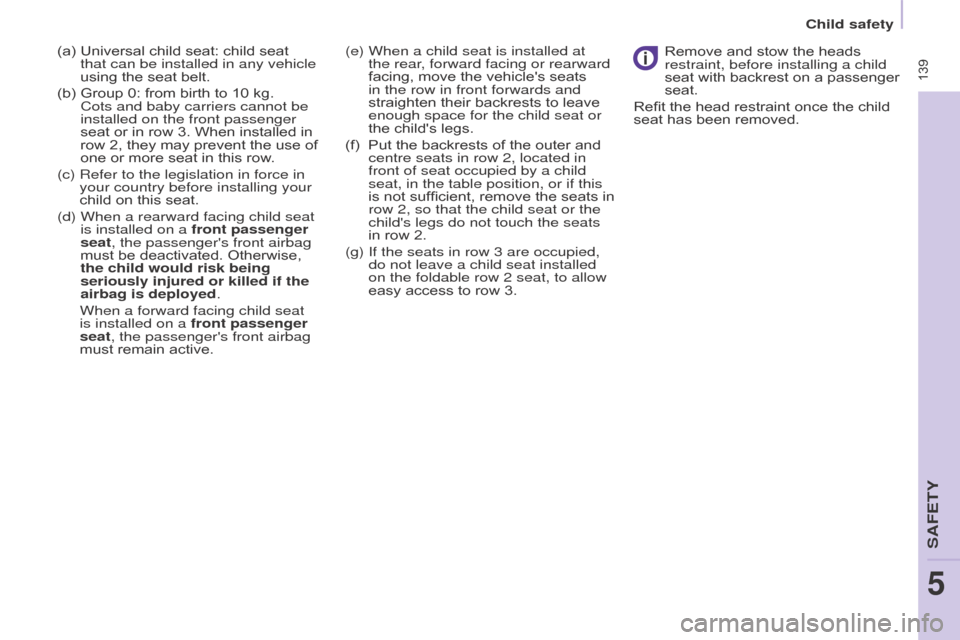
Berlingo-2-VP_en_Chap05_Securite_ed01-2015
139
(a) Universal child seat: child seat that can be installed in any vehicle
using
the seat belt.
(b)
Group
0: from birth to 10 kg.
Cots and baby carriers cannot be
installed on the front passenger
seat
or in row 3. When installed in
row
2, they may prevent the use of
one
or more seat in this row.
(c)
Refer to the legislation in force in
your country before installin
g your
child
on this seat.
(d)
When a rearward facing child seat
is installed on a
front passenger
seat, the passenger's front airbag
must
be deactivated. Otherwise,
the child would risk being
seriously injured or killed if the
airbag is deployed
.
When a forward facing child seat
is installed on a front passenger
seat, the passenger's front airbag
must
remain active. Remove
and stow the heads restraint, before installin
g a child
seat
with backrest on a passenger
seat.
Refit
the head restraint once the child
seat
has been removed.
(e)
When a child seat is installed at
the rear
, forward facing or rearward
facing,
move the vehicle's seats
in the row in front forwards and
straighten
their backrests to leave
enough space for the child seat or
the
child's legs.
(f)
Put
the backrests of the outer and
centre seats in row 2, located in
front of seat occupied by a child
seat, in the table position, or if this
is
not sufficient, remove the seats in
row 2, so that the child seat or the
child's legs do not touch the seats
in
row 2.
(g)
If the seats in row 3 are occupied,
do not leave a child seat installed
on the foldable row 2 seat, to allow
easy
access to row 3.
Child safety
SaFETY
5
Page 142 of 298
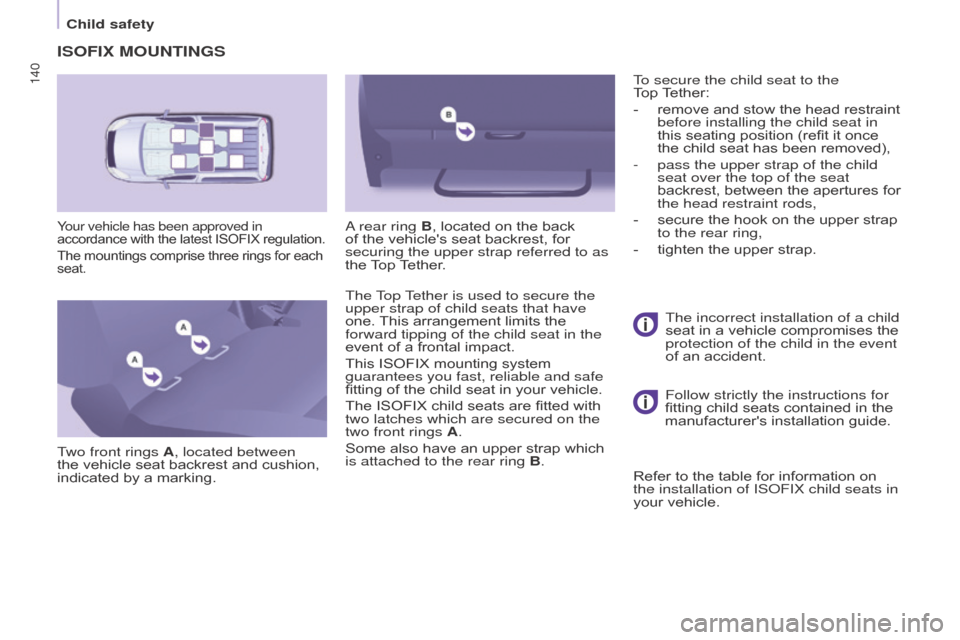
Berlingo-2-VP_en_Chap05_Securite_ed01-2015
140
ISOFIx MOUNTINGS
Your vehicle has been approved in
accordance with the latest ISOFIX regulation.
The
mountings comprise three rings for each
seat.
Two front rings A, located between
the vehicle seat backrest and cushion,
indicated
by a marking.
a rear ring
B, located on the back
of
the vehicle's seat backrest, for
securing the upper strap referred to as
the
T
op
T
ether.
The Top Tether is used to secure the
upper strap of child seats that have
one.
This
arrangement limits the
forward tipping of the child seat in the
event
of a frontal impact.
This ISOFIX mounting system
guarantees you fast, reliable and safe
fitting
of the child seat in your vehicle.
The ISOFIX child seats are fitted with
two latches which are secured on the
two front rings
A.
Some also have an upper strap which is attached to the rear ring
B.Follow strictly the instructions for
fitting
child seats contained in the
manufacturer's
installation guide.
To secure the child seat to the
Top Tether:
-
remove
and stow the head restraint
before installin
g the child seat in
this seating position (refit it once
the
child seat has been removed),
-
pass the upper strap of the child
seat over the top of the seat
backrest,
between the apertures for
the head restraint rods,
-
secure
the hook on the upper strap
to the rear ring,
-
tighten
the upper strap.
The incorrect installation of a child
seat in a vehicle compromises the
protection of the child in the event
of
an accident.
Refer to the table for information on
the installation of IS
o FIX child seats in
your
vehicle.
Child safety
Page 144 of 298
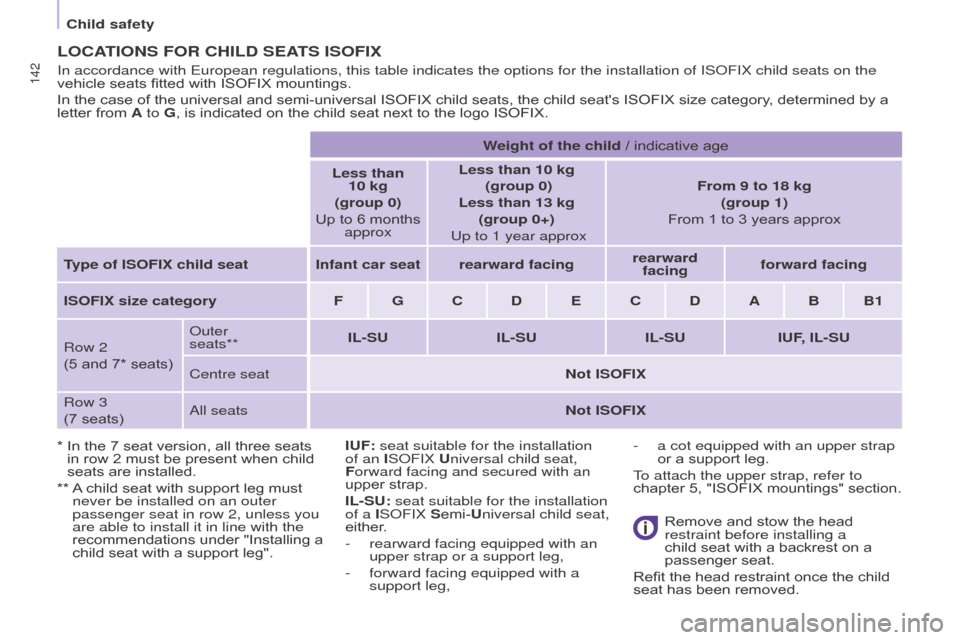
Berlingo-2-VP_en_Chap05_Securite_ed01-2015
142
LOCATIONS FOR CHILD SEATS ISOFIx
* In the 7 seat version, all three seats in
row 2 must be present when child
seats
are installed.
**
A
child seat with support leg must
never be installed on an outer
passenger seat in row 2, unless you
are able to install it in line with the
recommendations
under "Installing a
child
seat with a support leg".
In accordance with European regulations, this table indicates the option\
s for the installation of IS
o FIX child seats on the
vehicle seats fitted with ISOFIX mountings.
In the case of the universal and semi-universal ISOFIX child seats, the child seat's ISOFIX size category, determined by a
letter
from A to G, is indicated on the child seat next to the logo ISOFIX.
Weight of the child / indicative age
Less than 10 kg
(group 0)
Up to 6 months
approx
Less than 10 kg
(group 0)
Less than 13 kg (group 0+)
Up to 1 year approx From 9 to 18 kg
(group 1)
From 1 to 3 years approx
Type of ISOFI x child seat Infant car seat rearward facing
rearward
facing forward facing
ISOFI x size category
F G C D E C D A B B1
Row 2
(5 and 7* seats)
o
uter
seats** IL-SU
IL-SUIL-SUIUF, IL-SU
Centre seat Not ISOFI x
Row 3
(7
seats)
a
ll seats
Not ISOFI xIUF:
seat suitable for the installation
of an IS o FIX Universal child seat,
Forward facing and secured with an
upper
strap.
IL-SU: seat suitable for the installation
of a IS
o FIX Semi-Universal child seat,
either.
-
rearward facing equipped with an
upper strap or a support leg,
-
forward facing equipped with a
support leg, Remove
and stow the head
restraint before installin
g a
child
seat with a backrest on a
passenger
seat.
Refit
the head restraint once the child
seat
has been removed.
-
a cot equipped with an upper strap
or
a support leg.
To attach the upper strap, refer to
chapter
5, "ISOFIX mountings" section.
Child safety
Page 145 of 298
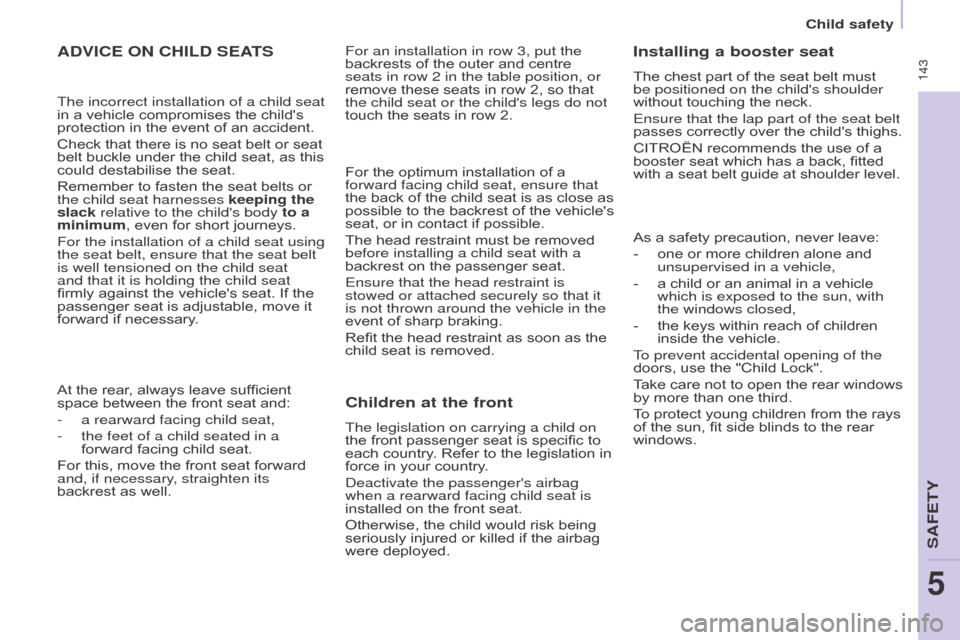
Berlingo-2-VP_en_Chap05_Securite_ed01-2015
143
ADVICE ON CHILD SEATS
At the rear, always leave sufficient space between the front seat and:
-
a rearward facing child seat,
-
the feet of a child seated in a
forward
facing child seat.
For
this, move the front seat forward
and, if necessary
, straighten its
backrest
as well.
The incorrect installation of a child seat
in
a vehicle compromises the child's
protection
in the event of an accident.
Check that there is no seat belt or seat
belt
buckle under the child seat, as this
could
destabilise the seat.
Remember to fasten the seat belts or
the child seat harnesses
keeping the
slack relative to the child's body to a
minimum, even for short journeys.
For the installation of a child seat using
the seat belt, ensure that the seat belt
is well tensioned on the child seat
and that it is holding the child seat
firmly against the vehicle's seat. If the
passenger
seat is adjustable, move it
forward
if necessary. For the optimum installation of a
forward facing child seat, ensure that
the
back of the child seat is as close as
possible
to the backrest of the vehicle's
seat,
or in contact if possible.
The head restraint must be removed
before installin
g a child seat with a
backrest on the passenger seat.
Ensure that the head restraint is
stowed or attached securely so that it
is not thrown around the vehicle in the
event of sharp braking.
Refit the head restraint as soon as the
child
seat is removed.Children at the front
The legislation on carrying a child on
the
front passenger seat is specific to
each
country. Refer to the legislation in
force
in your country.
d
eactivate the passenger's airbag
when a rearward facing child seat is
installed
on the front seat.
Otherwise,
the child would risk being
seriously
injured or killed if the airbag
were
deployed.
Installing a booster seat
The chest part of the seat belt must be positioned on the child's shoulder
without touching the neck.
Ensure that the lap part of the seat belt
passes
correctly over the child's thighs.
CITROËN
recommends the use of a
booster
seat which has a back, fitted
with
a seat belt guide at shoulder level.
As
a safety precaution, never leave:
-
one
or more children alone and
unsupervised in a vehicle,
-
a
child or an animal in a vehicle
which is exposed to the sun, with
the windows closed,
-
the
keys within reach of children
inside
the vehicle.
To prevent accidental opening of the
doors,
use the "Child Lock".
Take
care
not
to
open
the
rear
windows
by
more than one third.
To
protect young children from the rays
of
the sun, fit side blinds to the rear
windows.
For an installation in row 3, put the
backrests
of
the
outer
and
centre
seats in row 2 in the table position, or
remove
these
seats
in
row
2,
so
that
the child seat or the child's legs do not
touch
the
seats
in
row
2.
Child safety
SaFETY
5
Page 172 of 298
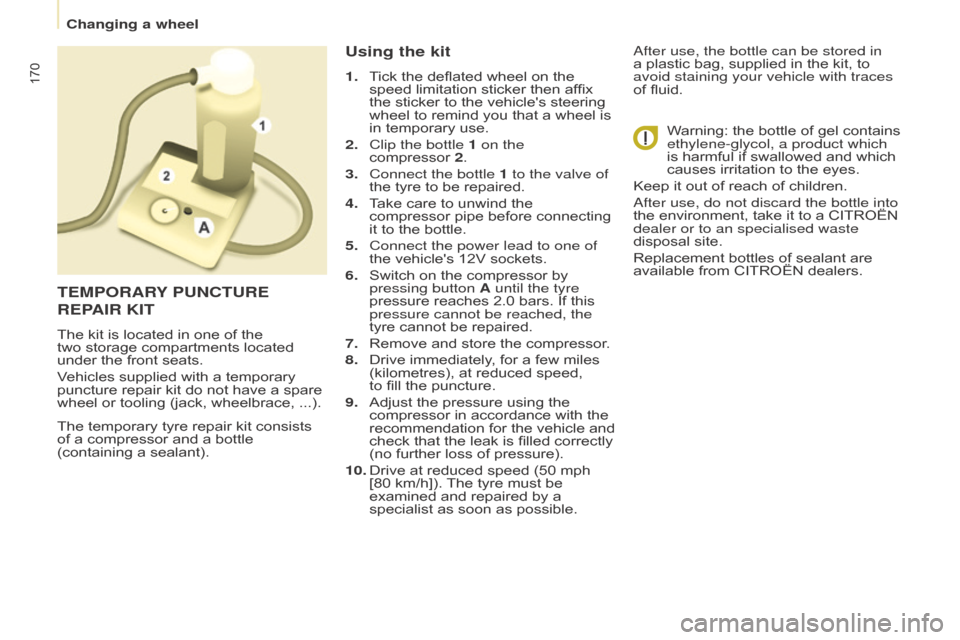
170
Berlingo-2-VP_en_Chap08_aide-rapide_ed01-2015Berlingo-2-VP_en_Chap08_aide-rapide_ed01-2015
The temporary tyre repair kit consists of a compressor and a bottle
(containing
a sealant).
Using the kit
1. Tick the deflated wheel on the speed
limitation sticker then affix
the
sticker to the vehicle's steering
wheel
to remind you that a wheel is
in
temporary use.
2.
Clip the bottle
1 on the
compressor 2.
3.
Connect the bottle
1 to the valve of
the
tyre to be repaired.
4.
T
ake care to unwind the
compressor
pipe before connecting
it
to the bottle.
5.
Connect the power lead to one of
the
vehicle's 12V sockets.
6.
Switch
on the compressor by
pressing button
A until the tyre
pressure
reaches 2.0 bars. If this
pressure cannot be reached, the
tyre
cannot be repaired.
7.
Remove
and store the compressor.
8.
Drive
immediately, for a few miles
(kilometres),
at reduced speed,
to
fill the puncture.
9.
Adjust
the pressure using the
compressor
in accordance with the
recommendation
for
the
vehicle
and
check
that the leak is filled correctly
(no
further loss of pressure).
10.
Drive
at reduced speed (50 mph
[80
km/h]).
The
tyre must be
examined
and repaired by a
specialist
as soon as possible.
a
fter use, the bottle can be stored in
a plastic bag, supplied in the kit, to avoid staining your vehicle with traces
of
fluid.
Warning:
the bottle of gel contains
ethylene-glycol, a product which
is
harmful if swallowed and which
causes
irritation to the eyes.
Keep
it out of reach of children.
a
fter use, do not discard the bottle into
the
environment, take it to a CITROËN
dealer or to an specialised waste
disposal
site.
Replacement
bottles of sealant are
available
from CITROËN dealers.
TEMPORARY PUNCTURE
REP
AIR KIT
The kit is located in one of the two storage compartments located
under
the front seats.
Vehicles
supplied with a temporary
puncture
repair kit do not have a spare
wheel
or tooling (jack, wheelbrace, ...).
Changing a wheel